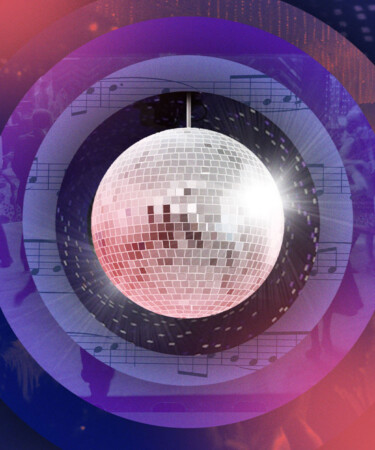“Everything old is new again,” legendary entertainer Peter Allen once said. Such is certainly the case with the disco ball, which has seen a recent resurgence in pop culture as ’70s styles come back into fashion. But before it became a TikTok trend, before the release of Taylor Swift’s and the Arctic Monkeys’ odes to the funky decor — and even before there were bell-bottom pants, uptempo dance music, and “Saturday Night Fever” to rocket it to fame — it was an electrician’s union that published the first record of what we now know as the disco ball.
Despite the fact that the disco ball is inextricably linked to the 1970s disco era, the first mentions of the ornamental piece, originally called a mirror ball, date all the way back to 1897. In Charlestown, Mass., members of an electrician’s union gathered for their annual ball and intended to cast incandescent light that could be “seen for miles around Boston.” In order to do so, the electricians developed incandescent lamps casting a number of colors and a carbon arc that all reflected off what they referred to as “mirror ball” in their magazine, the “Electrical Worker.”
At the start of the 1900s, mirror balls garnered some favor for their decorative appeal. However, it wasn’t until 1917 that the first patent for what was called a “myriad reflector” was filed by Louis Bernard Woeste. Pledging to fill dance halls with “dancing fireflies of a thousand hues,” the myriad reflector was produced and sold by Cincinnati-based Stephens and Woeste throughout the 1920s.
Popularity of the disco ball began to wane as the Roaring ’20s bled into the Great Depression, and Stephens and Woeste inevitably ceased production of the disco balls. The decoration was not produced again until the 1940s, when the design was picked up by Louisville-based Omega National Products.
With the Art Deco style dominating a multitude of art forms in the early to mid-1900s, furniture manufacturer Omega set out to create flexible mirrored sheets that could be upholstered to any number of items — including Liberace’s glass grand piano. As the only manufacturer of these mirrored sheets, Omega was quickly approached by a number of potential clients ranging from amusement parks to jukebox halls to produce mirror balls for their establishments.
At the start of production, 25 Omega workers — the majority of whom were women, as men were occupied with the World War II effort at the time — produced approximately 25 mirror balls per day in order to fill orders. The shimmering trinkets ranged from 2 inches in diameter to as large as 6 feet, with the average price of a 48-inch ball amounting to $4,000 — just about $20,000 in today’s dollars. At its height, Omega National was producing 90 percent of the world’s disco balls. The company continues to produce them for high-profile clientele including Beyoncé and Madonna, as well as for television programs like “Dancing With the Stars” and even the Oscars.
It wasn’t until the 1970s that the ornament would be strung up in glimmering discothèques and acquire its now famed name. While rather difficult to pin down the exact club that took the first leap with the disco ball, establishments like The Loft in New York City’s East Village certainly played an important role. It was here that a disco ball was suspended over the dance floor with a complete absence of all other light — a scene that later inspired disco icon Nicky Siano to install a disco ball in his own club, The Gallery, when it opened years later.
As the disco scene grew, so too did the disco ball’s popularity — entrancing dancers as Woeste’s fireflies glittered across their skin. By the 1980s, it was unusual to enter a dance hall or discothèque unequipped with its own disco ball. Despite the fact that the disco era came to an abrupt halt at the end of the ‘70s thanks to stunts like Disco Demolition Night in Chicago and the onslaught of the AIDS crisis, the disco ball remained a pop culture mainstay.
From Neil Young and Sarah McLachlan’s 1995 and 1999 albums both entitled “Mirrorball,” to icons like Madonna utilizing the structure to bust out onto stage while on tour in 2006, the disco ball refused to go down with its namesake era. Today, the disco ball is undergoing yet another revitalization due to ’70s nostalgia and TikTok home decor trends.
With many spending more time at home since before the start of the pandemic, many have looked for ways to brighten up their own spaces — and for some, the disco ball proved to be the perfect solution. One producer of disco balls, Libby Rasmussen, told The New York Times that in her first year of production during the pandemic, she received over 5,000 orders, and demand does not seem to be slowing any time soon.
While the disco era may be in the rearview mirror, the future remains shimmering and bright for the beloved disco ball.
